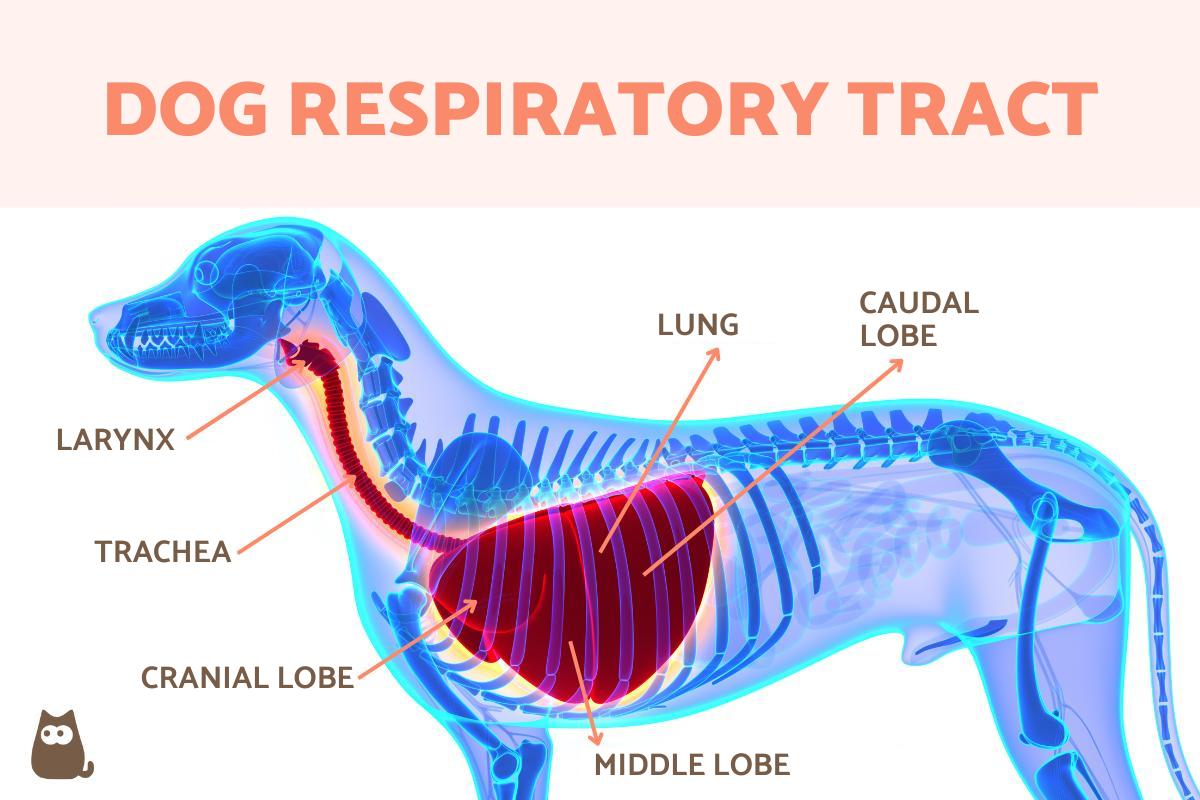The Dog Respiratory System Anatomy



See files for Dogs
The dog's respiratory system is very similar to that of humans. As with the human respiratory tract, air enters through the mouth and nose, ending up in the lungs via the trachea. Each part of the dog's respiratory system has its own specific function, the proper working of which is required for the dog to continue living. It is through respiration the dog intakes oxygen into the body, entering the blood stream and allowing their organism to function. It is a process which also creates waste such as carbon dioxide and releases it back into the environment.
At AnimalWised, we see how dogs are able to breathe by looking at the dog respiratory tract anatomy. We look at the lungs and other parts of the respiratory tract so we can see how they function.
How do dogs breathe?
Respiration is the movement of oxygen from outside of an organism into the tissues of their body. Although the oxygen travels through the respiratory tract, the actual conversion of oxygen occurs within the cells of the organism's tissues. This means that even unicellular organisms respire, but they do not necessarily breathe. Breathing requires particular apparatus which allows the intake of air for the purpose of respiration.
Dogs have an anatomy equipped with breathing apparatus in the form of their respiratory tract. It allows oxygren-rich air to enter the body and the process of respiration to occur in the cells. Once this process is complete, it also allows for the exhalation of air which also emits waste gases.
Respiration also occurs in other ways. Some animals have gills which allow them to respire underwater, even if they never experience breathing air in their lifetime. Although a dog has a trachea, insects have many trachea which allow them to take in oxygen and emit carbon dioxide after respiration. Some animals even breathe through their skin for respiration, although this is often in addition to using other parts of their anatomy to breathe.
The anatomy of a dog allows for pulmonary respiration, i.e. they breathe through their lungs. It is in the lungs that the gas-exchange process occurs. The ribs, chest musculature and the diaphragm enable breathing by working as a kind of ‘bellows’ to facilitate the inspiration and expiration of air.
The respiratory rate considered normal in a healthy adult dog is 24 breaths per minute at rest. There is a wide range of variation of normal breathing which can be between 10 and 30 breaths per minute. This often changes due to the breed since there is great variation in morphology[1].
Parts of the dog's respiratory system anatomy
A dog's respiratory system can be divided into upper and lower tracts. Broadly speaking, the upper respiratory tract in dogs comprises the nose, pharynx and larynx. The lower respiratory tract in dogs is made up of the bronchi and lungs. The trachea connects both tracts. We look at each of these elements in more detail:
- Nose: formed by the two nostrils and the nasal cavity which lead to the dog's throat. The maxillary and frontal sinuses connect with the nasal cavity. The mucosa of this cavity provides a defense against pathogens and irritants.
- Pharynx: the junction area between the nasal passages and the back of the mouth. This is where the epiglottis valve is located, a cartilaginous flap in charge of closing the larynx when the dog swallows to prevent any element from passing into the respiratory tract.
- Larynx: arranged above the trachea and below the epiglottis, it is composed of cartilage. It is where the vocal cords are located. Its interior is covered with a mucosa without cilia, which hinders the mobility of the mucus. Mucus can more easily adhere to it, making it easier for any pressure to trigger a cough. We can see an example in dogs that pull against neck collars and choke because of this action.
- Trachea: a tube with C-shaped cartilage rings which allow it to maintain its shape and facilitate the free passage of air without collapsing. It goes from the larynx to the main bronchi which carry air to the lungs.
- Bronchi: the main or primary bronchi (left and right) are divided into secondary bronchi. They are further subdivided into increasingly narrow ducts until they reach what are called bronchioles. They can be larger or smaller. In those of smaller size, the pulmonary alveoli are formed, also called alveolar sacs. It is here where gas exchange finally occurs.
- Lungs: two air-filled, elastic, spongy organs located in the chest cavity and protected by the ribs. We will talk about them in more detail in the following sections.
Learn about one of the worst diseases that can happen to a dog's lungs with our article on pulmonary edema in dogs.
How many lungs do dogs have?
As we have said, dogs breathe thanks to their lungs. Specifically, they have two lungs, one on the left and one on the right. They are divided into lobes by deep fissures. They dog's lung lobes are connected to each other and covered by a membrane known as the ‘pleura’. They are located in the pleural cavities between which is the mediastinum.
Anatomy of dog lungs
The internal structure of the lungs is reminiscent of a tree, branching out from the main trunks into individual branches of increasingly smaller size. The dog's lung lobes are anatomical divisions of the organ. The two main lungs are broken down into the following lobes:
- Right lung: cranial, middle, caudal and accessory lobes.
- Left lung: bilobed middle and caudal lobes[2].
Withing these lobes of the dog's lungs are the bronchi, bronchioles and alveoli. The latter is where gas exchange occurs, as we have already mentioned. Oxygen passes into the blood through them and carbon dioxide leaves thanks to a pressure difference.
If you see that your dog's breathing is fast and shallow, it is possible they are suffering from a disorder of the respiratory tract. It is important you speak to your veterinarian if you observe these clinical signs.

Tips to maintain the dog's respiratory system
Health problems involving the respiratory system in dogs can become serious, compromising the dog's breathing and, therefore, their life. Some will be unpredictable, but others we can control taking into account measures such as the following:
- See your vet at any sign of illness, such as runny nose, coughing or difficulty breathing. In our article, we talk about why a dog is coughing and gagging.
- Avoid going through places which have a lot of foreign bodies the dog can intake into their respiratory system. A common issue is foxtails in the summer which can enter the nasal cavity and stay there. Also, do not allow them to travel with their head outside the car window.
- Be careful with security. It is important that the dog does not have access to foreign bodies that may remain lodged in its respiratory tract or chemicals which can damage their respiratory tract tissue.
- Do not expose them to contaminants such as smoke or tobacco, as they cause irritation and encourage respiratory problems in dogs. Try to properly ventilate the home.
- Keep the schedule of deworming and vaccinations prescribed by the veterinarian. It is important to prevent the presence of pulmonary parasites and respiratory diseases.
- Try to keep them at their optimal weight. When a dog is overweight or obese, it can make breathing more difficult and reduce their life expectancy. Being overweight is not just an aesthetic issue.
- Use a harness better than a collar so as not to damage the trachea.
Now you know about the anatomy of a dog's respiratory system, you can check out our related article to learn more about the anatomy of dogs in general.
This article is purely informative. AnimalWised does not have the authority to prescribe any veterinary treatment or create a diagnosis. We invite you to take your pet to the veterinarian if they are suffering from any condition or pain.
If you want to read similar articles to The Dog Respiratory System Anatomy, we recommend you visit our Breathing diseases category.
1. Davis, M. S., Cummings, S. L., & Payton, M. E. (2017). Effect of brachycephaly and body condition score on respiratory thermoregulation of healthy dogs. Journal of the American Veterinary Medical Association, 251(10), 1160–1165.
https://doi.org/10.2460/javma.251.10.1160
2. Nakakuki S. (1994). The bronchial tree and lobular division of the dog lung. The Journal of veterinary medical science, 56(3), 455–458.
https://doi.org/10.1292/jvms.56.455





